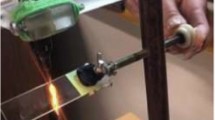Abstract
In this paper, the effect of the baffle on the mixing efficiency is studied when the baffle is distributed on the lower surface of the microchannel. The mixing efficiency of the micromixer was analyzed by numerical simulation. To study the change of mixing efficiency of micromixer, we changed the fractal number of baffles, height of baffles, spacing of baffles, angle of baffles, the number of baffles. Through analysis and comparison, we finally chose a micromixer with fractal number of 2, baffle height of 0.2 mm, baffle spacing of 0.25 mm, baffle angle of 45° and baffle number of 15.












Similar content being viewed by others
References
Han W, Chen X, Hu Z et al (2018) Three-dimensional numerical simulation of a droplet generation in a double T-junction microchannel. J Micro/Nanolithogr MEMS MOEMS 17(2):025502
Shi YZ, Xiong S, Zhang Y et al (2018) Sculpting nanoparticle dynamics for single-bacteria-level screening and direct binding-efficiency measurement. Nat Commun 9(1):815
Rahimi M, Aghel B, Alitabar M et al (2014) Optimization of biodiesel production from soybean oil in a microreactor. Energy Convers Manag 79:599–605
Tian Y, Chen X, Zhang S (2019) Numerical study on bilateral Koch fractal baffles micromixer. Microgravit Sci Technol 31(6):833–843
Babar H, Ali HM (2019) Towards hybrid nanofluids: Preparation, thermophysical properties, applications, and challenges. J Mol Liq 281:598–633
Zhao S, Chen C, Zhu P et al (2019) Passive micromixer platform for size-and shape-controllable preparation of ultrafine HNS. Ind Eng Chem Res 58(36):16709–16718
Montessori A, Lauricella M, Tirelli N et al (2019) Mesoscale modelling of near-contact interactions for complex flowing interfaces. J Fluid Mech 872:327–347
Montessori A, Lauricella M, Tiribocchi A et al (2019) Modeling pattern formation in soft flowing crystals. Phys Rev Fluids 4(7):072201
Montessori A, Lauricella M, Succi S (2019) Mesoscale modelling of soft flowing crystals. Philos Trans R Soc A 377(2142):20180149
Chen X, Shen J, Zhou M (2016) Rapid fabrication of a four-layer PMMA-based microfluidic chip using CO2-laser micromachining and thermal bonding. J Micromech Microeng 26(10):107001
Shi Y, Xiong S, Chin LK et al (2018) Nanometer-precision linear sorting with synchronized optofluidic dual barriers. Sci Adv 4(1):eaao0773
Jing D, Song S, Pan Y et al (2018) Size dependences of hydraulic resistance and heat transfer of fluid flow in elliptical microchannel heat sinks with boundary slip. Int J Heat Mass Transf 119:647–653
Jing D, Song J (2019) Comparison on the hydraulic and thermal performances of two tree-like channel networks with different size constraints. Int J Heat Mass Transf 130:1070–1074
Gidde RR, Pawar PM, Ronge BP et al (2018) Evaluation of the mixing performance in a planar passive micromixer with circular and square mixing chambers. Microsyst Technol 24(6):2599–2610
Chen X, Tian Y (2020) Passive micromixer with baffles distributed on both sides of microchannels based on the Koch fractal principle. J Chem Technol Biotechnol 95(3):806–812
Chen X, Tian Y, Zhang S (2020) Co2 laser ablation microchannel based on Koch fractal principle. Surf Rev Lett 27(05):1950141
Chen X, Liu S, Chen Y, et al (2019) A review on species mixing in droplets using passive and active micromixers. Int J Environ Anal Chem 1–11
Chen X, Li T (2017) A novel passive micromixer designed by applying an optimization algorithm to the zigzag microchannel. Chem Eng J 313:1406–1414
Gidde RR, Pawar PM, Ronge BP et al (2019) Flow field analysis of a passive wavy micromixer with CSAR and ESAR elements. Microsyst Technol 25(3):1017–1030
Bagherabadi KM, Sani M, Saidi MS (2019) Enhancing active electro-kinetic micro-mixer efficiency by introducing vertical electrodes and modifying chamber aspect ratio. Chem Eng Process-Process Intens 2019:107560
Kaneko K, Okano T, Hayakawa T, et al (2019) A pumpless mixer for efficient capturing of small particles utilizing vibration-induced flow. In: 2019 IEEE 32nd International Conference on Micro Electro Mechanical Systems (MEMS). IEEE, 2019: 406–408
Chen X, Li T, Zeng H, Zengliang Hu, Baoding Fu (2016) Numerical and experimental investigation on micromixers with serpentine microchannels. Int J Heat Mass Transf 98:131–140
Yuzhi S, Sha X, Lip KC et al (2018) Nanometer-precision linear sorting with synchronized optofluidic dual barriers. Sci Adv 4(1):eaao0773
Shi X, Wang L, Huang S et al (2019) A novel passive micromixer with array of Koch fractal obstacles in microchannel. J Dispers Sci Technol 2019:1–12
Zhang S, Chen X, Wu Z et al (2019) Numerical study on stagger Koch fractal baffles micromixer. Int J Heat Mass Transf 133:1065–1073
Acknowledgements
This work was supported by Young Taishan Scholars Program of Shandong Province of China(tsqn2020), Shandong Provincial Natural Science Foundation (ZR2021JQ).
Author information
Authors and Affiliations
Corresponding author
Additional information
Technical Editor: Daniel Onofre de Almeida Cruz.
Publisher's Note
Springer Nature remains neutral with regard to jurisdictional claims in published maps and institutional affiliations.
Rights and permissions
About this article
Cite this article
Tian, Y., Chen, X. Micromixer structure design based on Koch fractal principle and baffle distribution on the lower surface. J Braz. Soc. Mech. Sci. Eng. 43, 177 (2021). https://doi.org/10.1007/s40430-021-02905-w
Received:
Accepted:
Published:
DOI: https://doi.org/10.1007/s40430-021-02905-w




